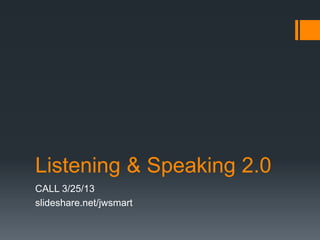
Listening & speaking
- 1. Listening & Speaking 2.0 CALL 3/25/13 slideshare.net/jwsmart
- 2. Listening & Speaking Monday Jon: Overview of tools in Listening & Speaking Jena: Skype Wednesday Turkan: Student podcasting & pronunciation Kristen: Youtube (watching and creating videos) Hongbo: Captioning videos Guanya: A/V CMC Bek: Making your own podcasts Wiki: Guanya & Hongbo
- 3. Listening Pedagogical challenges: 1. How can teachers/students sort through material and find what they need? 2. What kind of listening materials are best for our students (i.e., how authentic, how much support/scaffolding is needed)
- 4. Listening materials Authenticity issues Authentic materials to support authentic listening Podcasts Teacher-generated content: Why & How
- 5. Types of authenticity (Robin, 2011) 1. Authentic (content and delivery package are not made for language learners) 2. Semi-authentic (feels authentic to NS, but made for pedagogical purposes) 3. Authentic w/ scaffolding (original material packaged for learners). 4. Non-authentic (content and delivery designed for pedagogy) 5. Authentic materials w/ authentic support (often learner- generated)…probably the most novel & interesting from an educational perspective.
- 6. Authentic listening materials w/ authentic support (Robin, 2011) a) Repeatable material b) Short-length material c) Audio or video with transcripts or captions Scripts can be found for many movies and TV shows. Many Youtube videos (and other services) have captions Some A/V corpora also include scripts (e.g., CNCC) d) Material w/ background available elsewhere e) Non-commercial clip on user content sites f) Authentic interaction (what does authenticity mean, even within native speaker community)
- 7. Podcasts Podcasts can be audio (usually mp3) or video. You can subscribe to them or download individual episodes. (Nurmukhamedov & Sadler, 2012): 1. Discrete category: focused on a specific topic, often one speaker, short podcasts (e.g., Just Vocabulary Podcast) 2. ESL-focused: Speech adjusted, supplemental materials, transcripts. 3. General audience: most podcasts, based around topic or presenter(s), or series of speakers (TED, PSYCH 101) 4. ESL Super Podcasts: Multiple podcasts hosted by large organizations (e.g., BBC Learning English, Voice of America)
- 8. Podcast list (20 minutes) Go to the following Google Doc. Check out some of the podcasts listed in each category. Add others that you know of to the appropriate categories. goo.gl/EAgIf
- 9. Creating content for your learners: Why? Flip teaching – very popular idea in current pedagogy. Instruction (i.e., exposure to new material and ideas) occurs outside of the classroom through readings, recorded presentations, screencasting, etc.). In class time is used to facilitate learner-centered activities (i.e., work on problems, tasks, projects). Research still not entirely clear (especially for LLs) Infographic on Flip Teaching
- 10. Creating content for your learners: How? Creating Digital Stories (w/ narration) Asynchronous use of voice recording (e.g., Vocaroo, Audioboo, Voicethread) Screencasting (e.g., Jing, screencast-o-matic.com, or Showme if you have an iPad) Creating Youtube videos or other videos (e.g., Quicktime/Windows Media videos uploaded to LMS).
- 11. Speaking materials Technology can afford learners many opportunities for speaking and interacting. They can speak with others through ACMC (Audioboo) or SCMC (e.g., Skype). Learners can create their own audio/video content, such as: Recording their own presentations. Recording audio/video diaries Making their own videos/digital stories Creating their own podcasts.
- 12. Skype (Jena)
- 13. Youtube (also see Vine, Catch) Youtube has pedagogical applications for speaking and listening. Options for privacy settings/sharing. Listening: learners can subscribe to Youtube channels and create playlists Learners can use captions, comment on videos, repeat videos. Speaking: learners can create their own videos and upload them to Youtube (and share them w/ one another). They can respond to videos with their own videos. Sample activities: McGill on I-TESLJ
- 14. Let’s try it out (20 minutes) Choose one of the following. Work on your own or with a partner. Prepare to share your ideas with the class. 1. Podcasting: How could you work with learners to create podcasts? Brainstorm some ideas for language skills or topics that could be used in podcasting. 2. Youtube: How could you use Youtube (or Vine) to develop learners speaking AND listening abilities? Brainstorm some ideas for language skills or topics that could be used in creating videos. 3. Screencasting: Look at Jing, Screencast-o-matic, ShowMe or a similar service and brainstorm some ideas for using screencasting as an instructional tool in the classroom.
Notas del editor
- Open up the following sites before class: http://newsouthvoices.uncc.edu/nsv/narrativeshttp://goo.gl/EAgIf
- Authentic – content and delivery package are not made for language learners.
